Qualitative Data Analysis with ATLAS.ti
Student Resources
Mac instructions
These instructions are from Qualitative Data Analysis with ATLAS.ti (Third Edition), Chapter 6: Further Steps in the Data Analysis Process, copyright © Susanne Friese 2019.
These instructions are for version 8.3 of ATLAS.ti with the MacOS operating system.
Skills training 6.2: creating and working with smart codes
Creating smart codes in the Code Manager
In the Code Manager you can create smart codes combining codes with OR (ANY):
- Open the Code Manager and select the two codes: #fam: don’t want children and #fam: no children yet. Right-click and select the option CREATE SMART CODE.
- Change the name to #fam: don’t have children.
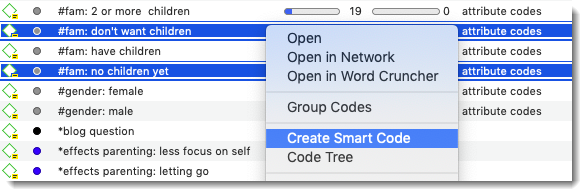
Figure 6.1 Creating an ORed smart code in the Code Manager
The Smart Code Tool
With version 8.4, ATLAS.ti Mac also has a Query Tool. This makes the Smart Code Tool more or less obsolete as you can also create a smart code based on a query that you create in the Query Tool. Both tools offer the same operators (Boolean, semantic and proximity operators). The Smart Code Tool currently is only needed if you want to edit a query (see below).
Below I explain how to create the same smart code as above in the Query Tool:
- Select ANALYSIS / QUERY TOOL from the main menu.
This opens the query tool where you can define the conditions for your query:
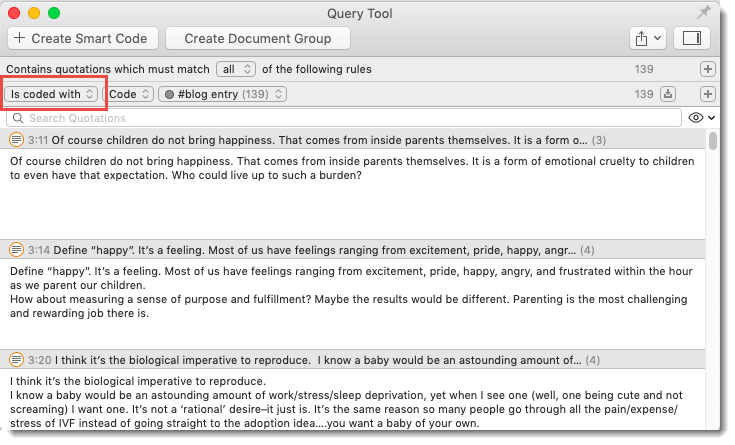
Figure 6.2 Query Tool after opening it
- Click on the field ‘is coded with’ and select the OR operator.
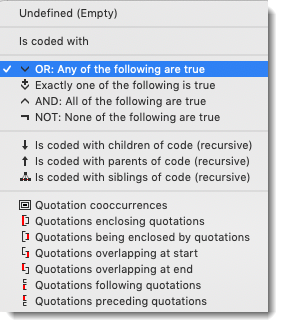
Figure 6.3 Set of Query Tool operators
- In the next two lines, select the two codes #fam: don’t want children and #fam: no children yet. The result of this query is 20 quotations.
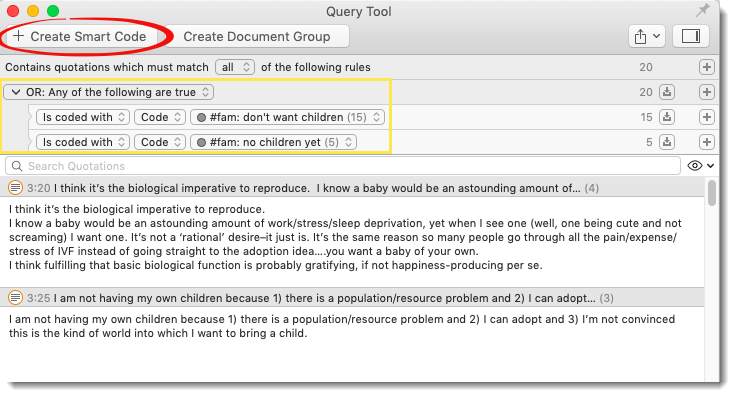
Figure 6.4 OR query in the Query Tool
- Click on the button Create Smart Code and enter the name #fam: don’t have children.
Editing smart code queries
If you get into the habit of clicking queries and develop a taste for complicated queries that you want to store as smart codes, you have the option to edit the query directly.
- Select the smart code in the Project Explorer or Code Manager, right-click and select EDIT QUERY. This opens the Smart Code Tool and you can edit the query.
Skills training 6.3: getting to know the Code Co-occurrence Table
For this exercise, I would like us to explore the following question:
RQ1: Do blog respondents who have children define happiness differently from those without children? If so, how do they define it?
- From the main menu select ANALYSIS / CODE COOCCURENCE TABLE.
- As row codes, select all ‘Def Happiness’ codes. If you type ‘Def’ into the search field, the list of codes is filtered to the category and you do not have to scroll. You can click on each box one-by-one, or you highlight all ‘def happiness’ codes and click the space bar. This selects all highlighted codes.
- In the list for the column codes, select the smart code we have created in Skills Training 6.2:#fam: don’t have children and the code #fam: have children.
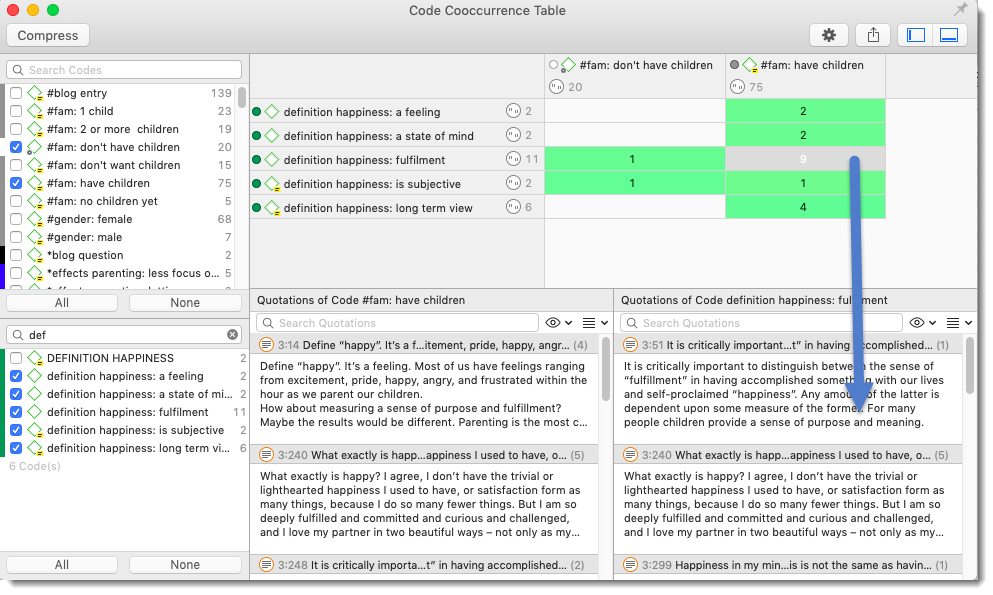
Figure 6.5 The Code Co-Occurrence Table
Skills training 6.4: getting to know the Code-Document Table
RQ2: Compare the reasons the male and female survey respondents have given for not having children.
- From the main menu select ANALYSIS / CODE DOCUMENT TABLE.
- Select the two document groups: Gender::female and Gender::male in the lower right-hand field.
- Select the codes from the category REASONS FOR NHC (NHC = not having children).
- Click on the button Compress to remove all rows and columns with empty cells
- If you click on a cell, the quotations are displayed below the table and you can read the data that is behind the number.
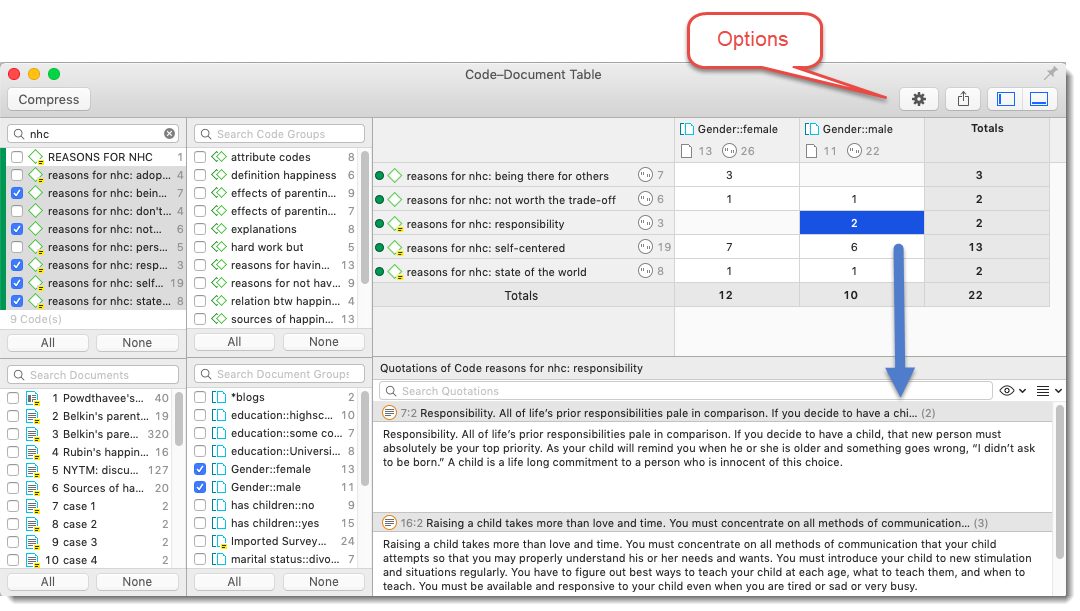
Figure 6.6 Code Document Table
Comparing code frequencies within document groups
- For a within group comparison, click the icon for OPTIONS and select COLUMN-RELATIVE.
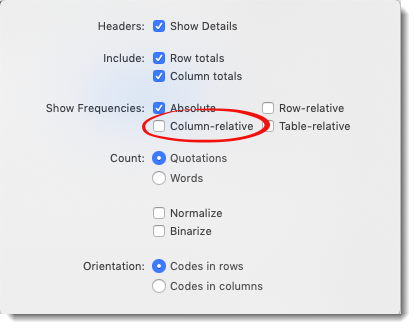
Figure 6.7 Code Document Table options
You must read this table from top to bottom along the columns.
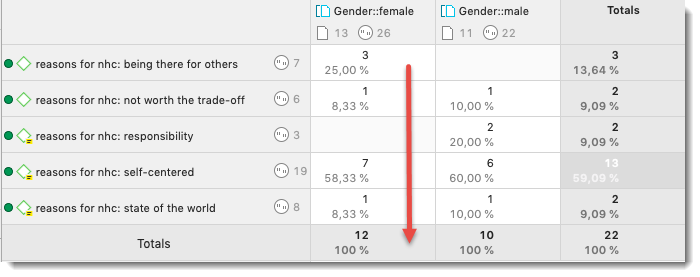
Figure 6.8 Code Document Table – within group comparison
Comparing code frequencies across document groups
- For an across group comparison, click OPTIONS and select ROW-RELATIVE.
This table must be read from left to right.
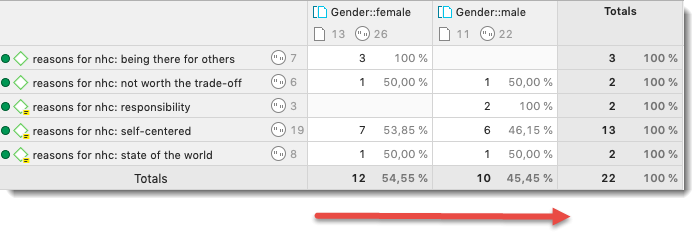
Figure 6.9 Comparing across document groups - relative row frequencies in the Code Document Table
(Note)
Depending on how you view the table: documents or codes in the rows or columns, the relative row or column frequencies refer to either the documents or the codes.
Normalizing data
Since the two groups of documents contain an unequal number of documents (there are 13 female respondents and 11 male respondents), you need to normalize the data to get accurate results.
- Click on OPTIONS again and in the Count section select NORMALIZE.

Figure 6.10 Comparing across document groups – normalized data
We also need to normalize when comparing document 3 and 5, which contain the comments to the parenting blog and the comments to the New York Times article. Document 3 contains 92 comments and document 5 only 47. Thus, if we were to look at frequencies (both absolute and relative) when comparing these two documents, it would not reflect the true difference (see Figure 6.11).
Prepare a new table by unselecting all previous selections – click on the button None below the lists.
Then select Documents 3 and 5 and the two code groups: effects of parenting positive and negative. Figure 6.11 shows the results with and without normalization.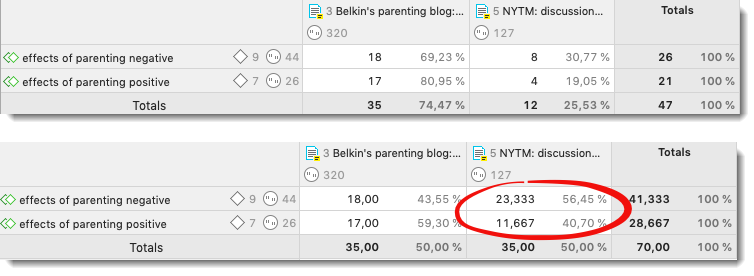 Figure 6.11 Relative code frequencies and unequal document length
Figure 6.11 Relative code frequencies and unequal document length
- Practice working with the Code-Document Table by examining the comments of the two blogs for other issues like negative effects of parenting, or reasons for or against having children.
Skills training 6.5: creating queries in the query tool
The Mac version currently has no visual interface for building queries. In the Mac version queries are built in the Query Tool or the Quotation Manager. The Quotation Manager has a few more option than the Query Tool and also allows you to set the scope.
- Thus, to create a query, you simply open the Quotation Manager, or you select the option ANALYSE / QUERY TOOL from the main menu.
If you build queries in the Quotation Manager, you first must select the filter icon and add the first query line. The Query Tool already shows the first query line if you open it.
In the Quotation Manager:
- Click on the filter button.
- Click on the plus (+) button to start building a query.
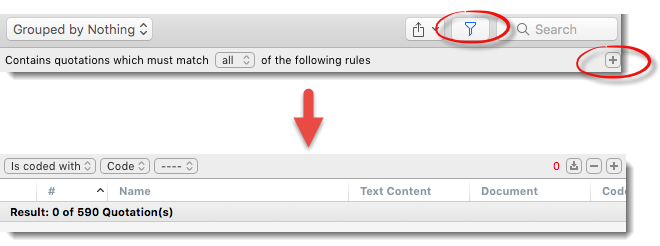
Figure 6.12 Starting a query
For the next exercise, I would like to explore the following question:
RQ3: Find all quotations where people critique the study design or address that the wrong questions have perhaps been asked.
You can use either the Query Tool or the Quotation Manager to build the queries unless otherwise indicated in the instructions.
- Click on the field ‘is coded with’ and select the operator OR: ANY OF THE FOLLOWING IS TRUE.
- Two more lines are added. In the fields with the three dots (…) select the code ‘study design: asking the wrong questions’ and the code ‘study design: critique’.

Figure 6.13 Building an OR query
Building a query using proximity operators
For practicing the proximity operators, we can explore the following question:
Find all quotations where people with more than two children describe their own definition of happiness.
- If you are using the Quotation Manager: Delete the previous query by clicking on the minus (-) in the first line of the query. Click on plus (+) again. Select the operator Quotation cooccurrences.
- If you are using the Query Tool: Exchange the OR operator with Quotation cooccurrences.
- As we want to read only the segments where those with two children talk about how to define happiness, we first need to select the code group ‘definition happiness’. After the field ‘coded with’, click on the drop-down arrow in the second field and select ‘code group’.
- In the second row select the code ‘#fam: 2 or more children’ (see Figure 6.14).
If we were to enter the code ‘fam: 2 or more children’ first, we would get the entire response of all respondents with two children and not only the parts where they talk about the definition of happiness. See Skills Training 6.1: Proximity operators in the book.
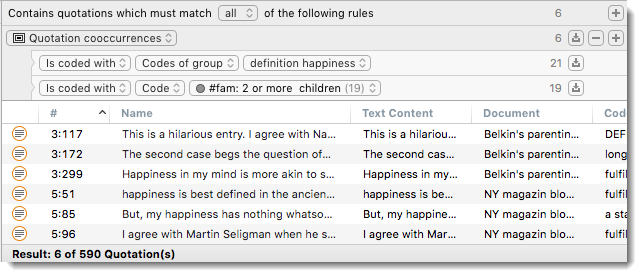
Figure 6.14 Building a code co-occurrence query
Building more complex queries
To find an answer to the next question, we need a combination of two operators:
RQ4: Do parents who report negative aspects of parenting also talk about positive aspects?
What we want to find are comments written by those who have children (code: #fam: have children) that contain both, quotations that have been coded with any of the codes from the category ‘effects positive’, or with any of the codes from the category ‘effects negative’. The codes may overlap, or they are embedded within the comment.

Figure 6.15 Illustration of what we want to find with research question 4
We can retrieve all quotations of these two categories via their respective code group. In the Mac version, it is easier to build this query in two steps: first by creating a smart code and then using this smart code in a subsequent. I will also show you, how to build the query without creating a smart code first.
Let’s start by finding all blog posts where parents write about negative effects of parenting. You need to use the Query Tool now.
- Open the Query Tool (ANALYSIS / QUERY TOOL).
- As operator select: QUOTATIONS ENCLOSING QUOTATIONS.
- The attribute code has always been applied to the entire comment. As we want to retrieve the entire comment, we need to enter the ‘#fam: have children’ code in the first line.
- In the second line, enter the code group ‘effects of parenting negative’ (Figure 6.16).

Figure 6.16 Query for RQ4 part 1
- Click on the button Create Smart Code and enter as name: *Parents who write about negative effects.
As we only want to find comments where parents raise both positive and negative issues around parenting, we need to find all positive statements within comments that contain negative statements, which are captured by the smart code we have just created. The operator remains the same. QUOTATIONS ENCLOSING QUOTATIONS. We just need to exchange the terms in the query.
- In the first line, select the smart code that you have just created.
- In the second line, select the code group ‘effects of parenting positive’ to complete the query.

Figure 6.17 Query for RQ4 part 2
The resulting number of quotations for this query is 8. Thus, eight parents have written about both positive and negative effects of parenting.
- Take a look at the quotations below the query. You will see that all eight quotations always include the complete commentary.
If you are curious about how you can build the query without the smart code, look at Figure 6.18.

Figure 6.18 Query for RQ4 without using a smart code
We need to use two queries and for the resulting quotations, both rules must apply (operator all). The first rule finds all comments where parents talk about negative effects; the second rule finds all comments where parents talk about positive effects. As we are only interested in those comments where they talk about post type of effects, we need the intersection where both occur – hence combining both queries with the operator all.
This is how you build the query:
- Start by selecting all in the top row.
- Set the first embedding rule by clicking on the embed rule button for the first operand in the query
- Select the operator QUOTATIONS ENCLOSING QUOTATIONS (Quotation cooccurrences can be used as well for this query).
- In the first line select the code ‘#fam: have children’.
- In the second line enter the code group: ‘effects of parenting negative’.
- Click on the + button:

Figure 6.18 Add the second rule
- Select the operator QUOTATIONS ENCLOSING QUOTATIONS (or Quotation cooccurrences).
- In the first line select the code ‘#fam: have children’.
- In the second line enter the code group: ‘effects of parenting positive’.
After entering the operands for the second embedded rule, your query should look like the one in Figure 6.18.
An alternative solution to answer RQ4 is shown in Figure 6.19.

Figure 6.19 Alternative solution for RQ4
To build this query, you need to use an embedded rule:
- To remove any existing query in the Query Tool, click on the operator in the first line and select ‘Undefined (Empty)’.
- Next, select the operator QUOTATIONS COOCCURRENCES.
- To embed a rule, click on the ‘embed’ button on the right-hand side as shown in Figure 6.20 and select the operator QUOTATIONS ENCLOSING QUOTATIONS (or Quotation cooccurrences).

Figure 6.20 Adding an embedded rule
- For the embedded query in line 1 enter ‘is coded with / code / #fam: have children’, and in line 2 ‘is coded with / code group / effects of parenting negative’.

Figure 6.21 Embedded query
- The last line is actually line 2 of the surrounding query. Enter ‘is coded with / code group / effects of parenting positive’ (Figure 6.19).
Now you should be ready to build your own query. Here is your challenge:
RQ5: How do people who question the study design see the relationship between happiness and children?
To answer this question, you need the following codes.
- #blog post
- study design: asking the wrong question / study design: critique, or the previously created smart code: study design: raising doubts
- children: < happiness
- children: = level of happiness
- children: > happiness
- children: unrelated to personal happiness
Hint: You need to use both the query tool and the code co-occurrence table, and you need to create a smart code. You will find the solution to the problem at the end of the chapter.
Skills training 6.6: learning about code queries in combination with document attributes
For this exercise, we will use the survey data in the project, as we have lots of document attributes (= document groups) to play with. Let’s explore the following question:
RQ6: Compare the answers of male and female respondents regarding the reasons given for wanting children.
- Just to get a feeling for the data, open the Document Manager and select case 6. It is a single woman with some college education, who has no children and who answered the single choice question whether children bring happiness or not with ‘Yes’.
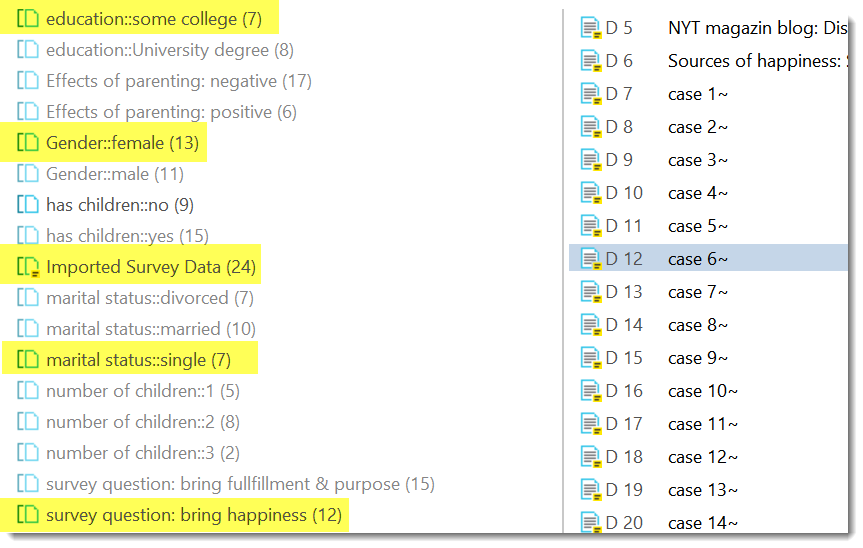
Figure 6.22 Check document group memberships for a case (or document)
You are already familiar with the Code Document Table, which could also be used to answer this research question. An alternative option is to create a query in the Quotation Manager. Filtering the results of a query by documents or document groups is currently only possible in the Quotation Manager.
- Remove the last query (if any).
- Click on the plus (+) button and enter the code group ‘reasons for having children’ into the first line.
- Click on the plus (+) button and enter as second rule: ‘is in – document of group – Gender::female’.
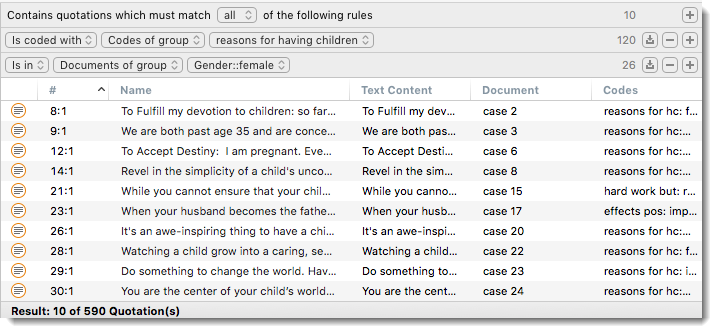
Figure 6.23 Restricting results to a subset of the data
- After reading the quotations or creating a report, change the second rule to ‘Gender::male’.
- Read the quotations of all male respondents to see if they give reasons other than women, how they present them, and what arguments they use. Even if this is just a simple query, by comparing and contrasting responses or statements of people from different groups, often lots of insights are gained.
Query results can also be restricted to single documents or a combination of documents and document groups. In the next exercise, I would like to show you how to compare answers of married and single women. Before you read on, think which operator do we need to create a new sub set for ‘married women’ and one for ‘single women’?
- Correct: we need the intersection between all female and all married respondents, which means we need to use the AND operator and an embedded rule.
- Remove the last line of the query (should be is ‘in document group Gender::male’) by clicking on the minus (–) button.
- Click on the plus (+) button to add a new line and then on the embedded rule button. Select the AND operator.
- Add the document groups ‘Gender::female and marital status::married’. The order does not matter.
- The results show 4 quotations.
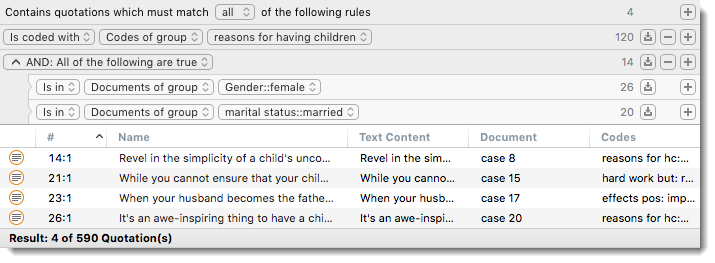
Figure 6.24 Restricting results to a subset of the data based on a combination of document groups
- Change the scope to single women by exchanging the code group ‘marital status::married’ and adding the document group ‘martial status::single’. The results also show 4 quotations.
If you need a certain combination of groups more often, you can also create smart groups instead of having to create them anew again in the Scope Tool. How this is done is shown in the next skills training.
Skills training 6.7: creating smart groups
- Open the Document Manager.
- Select two or more groups in the side panel. Check the operator setting that you see on top of the document list. You can switch between ANY and ALL.
- Right-click on one of the selected document groups and select NEW SMART GROUP.
A concrete example would be:
- Select the two groups ‘Gender::female’ and ‘marital status::married’ by holding down the cmd -key.
- Check that the operator is set to ALL, right-click and select NEW SMART GROUP (Figure 6.23).
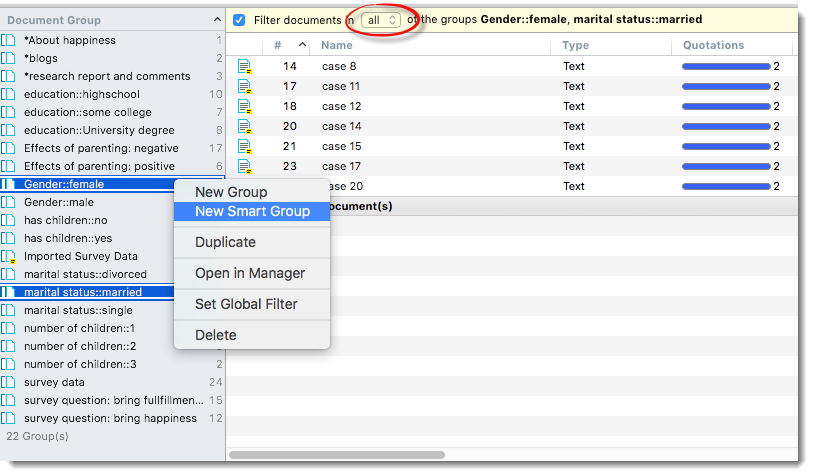
Figure 6.25 Creating smart document groups
Skills training 6.8: working with global filers
Here is another research question to explore. The survey contained two yes/no questions.
– Do you believe that children bring fulfilment and give life a purpose?
– Do you believe that children bring happiness?
Based on their answers, the respondents were added to a respective document group: survey question: bring fulfilment & purpose / survey question: bring happiness.
- Open the Quotation Manager. Click on the pin on the top right of the window, so that the window stays on top and place it next to the Project Explorer.
Here is the research question.
RQ7: Do respondents differ in their reasons for having children according to whether they mean that children are more about joy, or more about fulfilment and purpose in life?
- Select all reasons for having children codes (reasons for hc) in the side panel of the Quotation Manager.
- Open the document group branch in the Project Explorer
- Right-click on the document group ‘survey question: bring fulfilment & purpose’ and select the option SET GLOBAL FILTER.
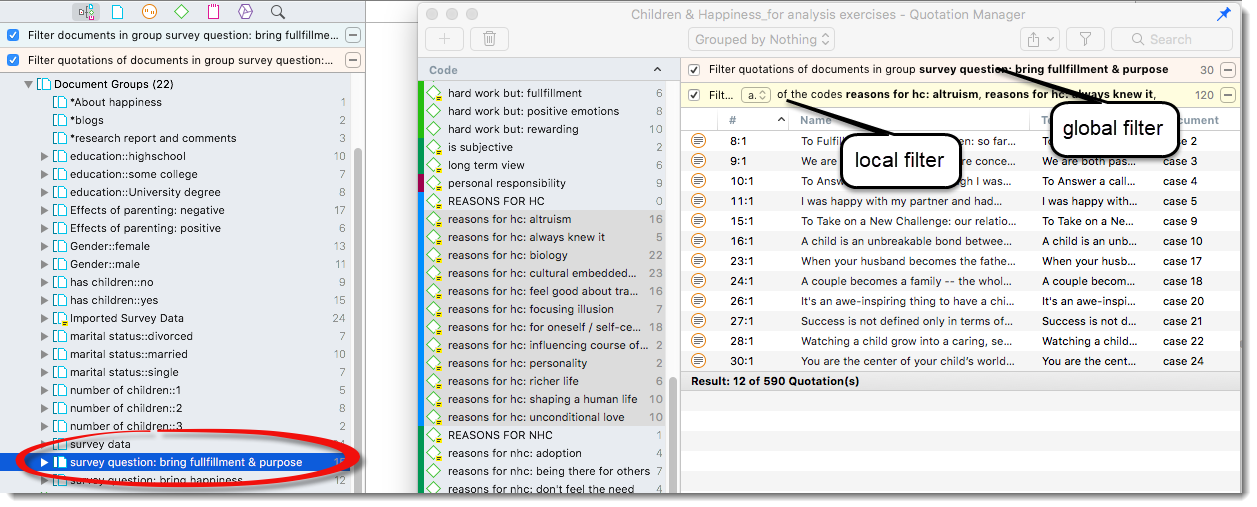
Figure 6.26 Setting a global document filter
Your screen should look like Figure 6.26. As we have set a global document filter, you will see a blue and an orange bar at the top of the Project Explorer indicating which documents and quotations have been filtered.
The codes selected in the side panel of the Quotation Manager filter the list of quotations. As explained in Skills Training 3.2, this is a local filter setting as it only affects the Quotation Manager. Local filters are indicated by the pale-yellow bar above the list of quotations. As the global document filter also affects which quotations are displayed, you see a second bar below it indicating the global filter. The results show all quotations of the selected codes (=local filter) but only for those documents contained in the global filter.
The colour scheme for global filters is as follows:
- Global document filters are blue.
- Global quotations filters are orange.
- Global code filters are green.
- Global memo filters are magenta.
- Global network filters are purple.

Figure 6.27 Global filter colour schema
You can deactivate the filter by unchecking the box. You can remove the filter by clicking on the minus (-) button.
Coming back to research question 7:
- Look at the results in the Quotation Manager and read the quotations. You see which of the codes have been applied in the Codes column next to the quotations or create a report that also contains all codes that have been applied.
- Next, change the global filter in the document group branch to ‘survey question: bring happiness’ by right-clicking on the document group and selecting SET GLOBAL FILTER. This automatically removes the previous filter. Read the quotations and compare.
Global filters in the Code Co-occurrence Table
RQ8: Compare the difference between those people with and without children regarding their attitudes whether children bring happiness. Is there a difference between people commenting Belkin’s blog as compared to those commenting on the New York Times magazine article?
- Create two document groups, one that only contains document 3 (Parenting blog), and one that only contains document 5 (NYTM). This is currently still needed as you cannot set a single document as global filter.
- Open the Code Co-occurrence Table next to the Project Explorer. Click on the pin so that the window stays on top.
- In the Code Co-occurrence table, select the ‘codes #fam: have children’ and ‘#fam: have children’ as column codes, and the ‘children < / = > happiness’ codes as row codes.
- Set the document group: Parenting blog as global filter. Inspect the results.
- Change the global filter to the document group: ‘NYTM’. Figure 6.28 shows the differences. If you deactivate the filter, you see the results for the entire data set.
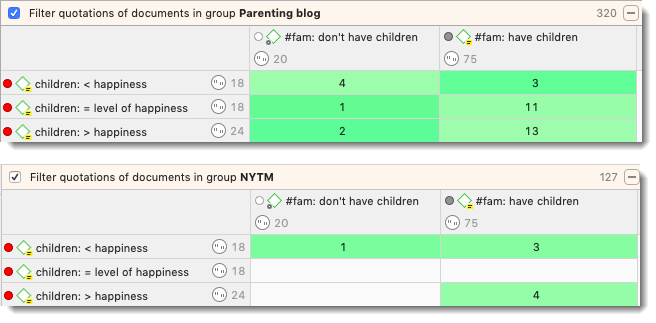
Figure 6.28 Global filters in the Code Co-occurrence Table
What we can conclude is that this comparison is not very meaningful, as very few people who have commented on the New York Times articles have expressed their attitude. In addition, there are, overall, many more comments in document 3 than in document 5 (320 vs 127). Like the discussion in Skills Training 6.4, for a meaningful comparison it would be useful to normalize the data first. This option might be added in a later version of ATLAS.ti.
Global filters in the Code-Document Table
Figure 6.29 shows two Code-Document tables. The number of reasons mentioned for having and for not having children across different educational levels and gender are compared. In addition to the absolute frequencies, the relative code frequencies are shown. To create the tables:
- Open the Code-Document Table. Pin it, so it stays on top.
- Select the three documents groups that represent the education levels and the two code groups that will give you the number of times someone has mentioned a reason for or against having a child.
Set the following options:
- Switch the rows and columns.
- Normalize the data.
- Sctivate the relative column frequencies.
- Next, set the document group ‘Gender::female’ as global filter in the document group branch in the Project Explorer. Review the results.
- Set the document group ‘Gender::male’ as global filter in the document group branch in the Project Explorer. Review the results.
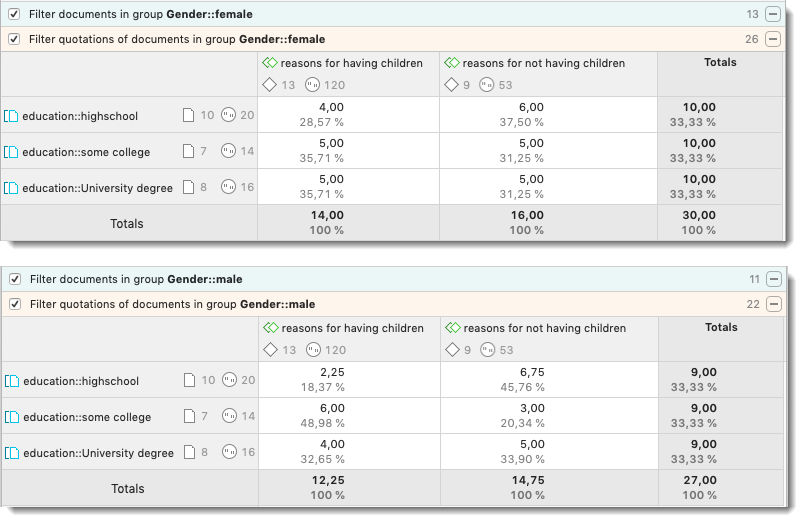
Figure 6.29 Global filters in the Code-Document Table (data are normalized!)
Without normalizing the data (see the same skills training in the book), the interpretation would be: Men with university degrees give more reasons to have children or not to have children. For women, the opposite picture emerges, those with lower degrees indicate more reasons.
As the number of respondents in each educational group is different, we have a good reason to normalize the data. Take a look at Figure 6.29 and see how the results change. How should the interpretation be adapted?
Solutions
Skills training 6.5: step-by-step instruction to answer RQ5
RQ5: How do people who question the study design see the relationship between happiness and children?
- Use the query tool as we need to save the result as smart code.
- We need to build an embedded query again. The aim is to find all blog entries where respondents either critique the study design or write that the researchers have been asking the wrong questions. Start with selecting the operator Quotations enclosing quotations.
- Add the code ‘’#blog entry’ in the first line.
- Open an embedded rule for the second line by selecting the OR operator.
- Add the two codes ‘study design: asking the wrong question’ and ‘study design: critique’.

Figure 6.30: Last step to answering RQ5 – creating a code co-occurrence table
- This query leads to 23 quotes. As we want to continue to work with the query, save the query as smart code and name it for instance *respondents who question the study design. If you add an asterisk (*) at the beginning of the code label, the code is listed in the upper part of the code list, and it is easier to find. It does not ‘get lost’ in all other category codes.
- Open the Code Co-Occurrence Table and create a table with the smart code as column code and the four attitude codes as row codes.

Figure 6.31 Solution to RQ5
You may be a little disappointed with the results after trying so hard to create the query. Remember, it was just an exercise :-). What we can read from the table is that most of those who question the study design did not mention how they see the relationship between happiness and children. When they did, they expressed a neutral attitude.
